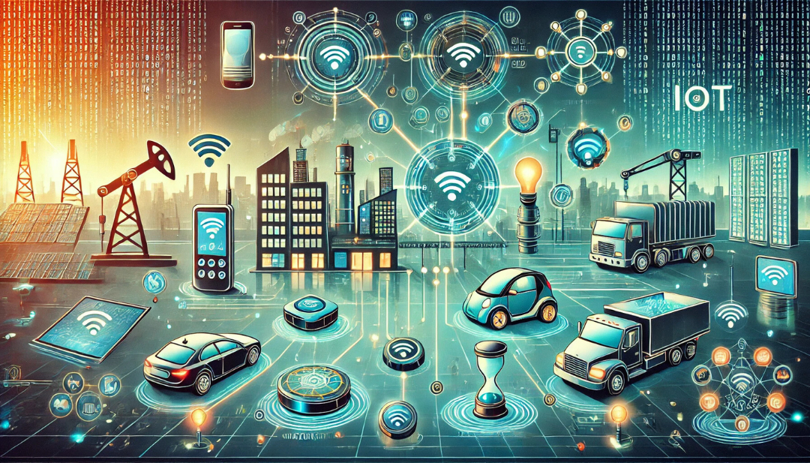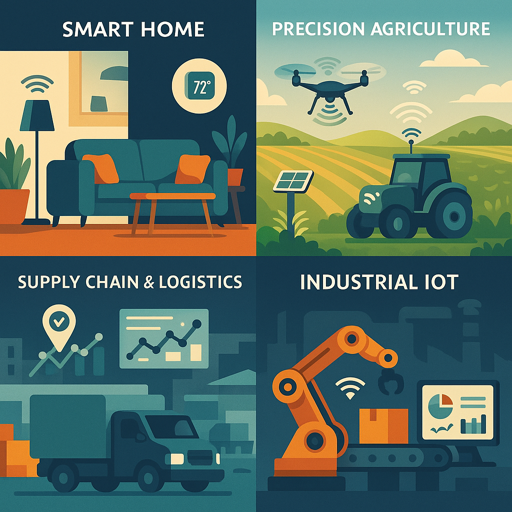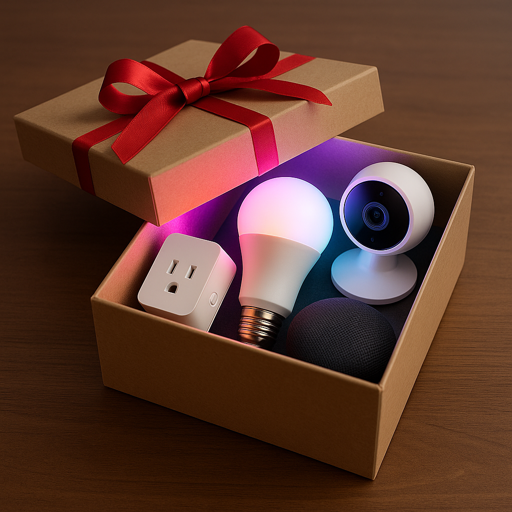This post may contain affiliate links. If you click through and make a purchase, we may earn a commission at no additional cost to you. This helps support our work and allows us to continue providing valuable content. For more information, please see our disclosure policy.

Picture this in your mind: Your alarm goes off on a Monday morning and before you’ve even opened your eyes, your coffee maker has already started brewing, your thermostat has warmed the house to your preferred temperature and your garage door is opening for the grocery delivery your smart fridge ordered over the weekend.
This may sound like a scene from a science fiction movie, but it really is just another day powered by Internet of Things (IoT) technology. What started as a futuristic concept is now so seamlessly integrated into our daily routines that we barely notice the dozens of smart devices working behind the scenes to make everything run smoothly.
What Makes IoT So Powerful?
At its core, IoT transforms ordinary objects into intelligent, connected devices that can sense, think and act without constant human input. From door locks to industrial machinery, these smart devices collect data, communicate with other devices and make decisions automatically.
Think of IoT as giving your physical world a nervous system. Just as your body’s nerves constantly send information to your brain, IoT sensors continuously feed data to connected systems, allowing everything to work together harmoniously.
The real magic happens when these devices don’t just connect to the internet, but start talking to each other, learning from patterns and anticipating needs before problems arise.
IoT Use Cases Transforming Our Daily Lives
Smart Homes
The most visible IoT use cases often start at home, where smart devices are turning houses into responsive, intelligent environments.
- Climate Intelligence: Smart thermostats like the Nest Learning Thermostat learn your habits, track when you’re home or away, and even factor in weather forecasts to optimize both comfort and energy bills. Some users report saving 10-15% on heating and cooling costs without lifting a finger.
- Security That Never Sleeps: Today’s home security systems create invisible protective bubbles around your property. Ring Video Doorbells let you see and speak with visitors from anywhere in the world, while smart locks can automatically secure your home when your phone indicates you’ve left the area.
- Appliances with Brains: LG’s ThinQ refrigerators can track expiration dates and suggest recipes based on available ingredients, while smart ovens can be preheated remotely so dinner starts cooking the moment you walk through the door.
- Lighting That Reads the Room: Philips Hue smart lighting systems can automatically adjust throughout the day to match natural circadian rhythms, gradually dimming in the evening to promote better sleep, then slowly brightening in the morning to ease you awake.
Precision Agriculture
Agriculture might seem traditional, but it’s undergoing a dramatic transformation thanks to IoT and smart sensors. Modern farmers are increasingly using data to make decisions rather than relying on intuition alone.
- Soil Intelligence: Companies like CropX have developed sensor networks that continuously monitor soil conditions, including moisture levels, nutrient content, pH balance and temperature at multiple depths across fields. This ground level data helps farmers apply water and fertilizer exactly where and when needed, reducing waste while maximizing crop yields.
- Drones for Precision Scouting and Treatment: While soil sensors look beneath the ground, drones provide a bird’s eye view. They have become indispensable tools in precision agriculture, not just for spraying, but also for mapping, diagnosis and planning interventions with remarkable accuracy. One compelling use case comes from EagleNXT’s eBee X drones, which helped convert a cattle ranch in Paraguay into productive cropland.

Supply Chain and Logistics
Behind every delivery lies a hidden IoT backbone ensuring the right products arrive on time.
- Fleet Intelligence: Modern trucking companies use IoT sensors to monitor everything from fuel consumption and engine performance to driver behavior and cargo conditions. This data helps optimize routes, predict maintenance needs and ensure regulatory compliance. Given that over 70% of U.S. goods travelled by truck in 2024 according to the American Trucking Association, these optimizations have massive economic impact.
- Smart Inventory Management: Warehouses now use IoT sensors to automatically track inventory levels, predict stockouts and trigger reorders. Amazon’s fulfillment centers employ thousands of sensors and robotic systems that can locate and move products with minimal human intervention.
- Cold Chain Monitoring: For temperature sensitive goods like vaccines, food or pharmaceuticals, IoT sensors provide continuous monitoring throughout the entire supply chain. If a refrigerated truck’s temperature rises above safe levels, the system can automatically alert drivers, reroute shipments or notify recipients before products are compromised.
Industrial Manufacturing
Industrial Internet of Things (IIoT) represents perhaps the most sophisticated application of connected technology, transforming factories into intelligent, self-optimizing systems.
- Predictive Maintenance Revolution: Instead of following rigid maintenance schedules or waiting for equipment to break down, manufacturers now use IoT sensors to monitor machinery health in real-time. These systems can detect subtle vibration changes, temperature variations or unusual sounds that indicate impending failures, often weeks before human technicians would notice problems. According to McKinsey, this approach can reduce unplanned downtime by up to 50% and extend equipment life significantly.
- Quality Control Automation: IoT-enabled vision systems are now catching defects that human inspectors might miss. At BMW’s Regensburg plant, AI-powered cameras and sensors continuously scan vehicles during production, detecting surface flaws and component deviations in real time. This integration of IoT and AI ensures consistent quality while reducing costly manual inspections.
- Worker Safety Enhancement: Smart sensors monitor workplace conditions continuously, detecting hazards like gas leaks, excessive noise or environmental stress. In advanced systems, analytics may also flag fatigue or risky behavior patterns, enabling proactive alerts before incidents occur.
Environmental Monitoring
Environmental IoT use cases are giving us unprecedented insight into our beloved planet’s health, enabling faster responses to environmental threats and better resource management.
- Air Quality Networks: Cities around the world are deploying denser networks of air quality sensors that can offer finer grained, near real-time pollution data beyond what traditional stations provide. In some places, authorities use this data to issue local health alerts or tailor traffic restrictions to specific neighborhoods.
- Water Quality Guardians: Municipal and wastewater treatment facilities increasingly deploy IoT sensor arrays to monitor multiple water quality parameters (e.g. pH, turbidity, dissolved oxygen, flow, temperature). Continuous monitoring enables much faster anomaly detection and regulatory compliance checks. In many modern systems, deviations can be identified in minutes rather than days.
- Wildlife Conservation Technology: IoT tracking devices help conservationists monitor endangered species with minimal human interference. GPS collars on large mammals, tiny sensors on migratory birds and underwater monitors tracking marine life provide vital insights into behavior patterns, migration routes and habitat needs that inform more effective protection strategies.
The Language of Smart Devices: Communication Protocols
For all these IoT use cases to work seamlessly, devices need to speak common “languages”. Communication protocols serve as the universal translators enabling different devices to understand each other.
- Zigbee creates mesh networks where devices can relay messages through each other, extending communication range and improving reliability. If one device goes offline, messages can automatically find alternate routes through the network.
- Z-Wave offers another robust mesh networking option, particularly popular in home automation because of its strong security features and ability to work reliably, even in crowded wireless environments.
- Matter represents the newest evolution in device communication. Launched in late 2022 with backing from Amazon, Apple, Google and other tech giants, Matter aims to create a universal standard where any smart device can work with any smart home platform, regardless of manufacturer.
The Quiet Revolution
What makes IoT truly remarkable isn’t the technology itself, but how invisible it’s becoming. The best IoT implementations work so seamlessly that we almost forget they exist. Your thermostat learning your schedule, your car alerting you to maintenance needs, your city smoothing traffic before jams form – these conveniences feel natural because they solve real problems without requiring technical expertise from users.
Whether you’re a farmer using precision agriculture techniques, a manufacturer implementing predictive maintenance or simply someone who appreciates that their smart speaker knows tomorrow’s weather forecast, IoT has evolved from a technological curiosity into an essential infrastructure.
Like electricity in the early 20th century, IoT is becoming so fundamental that we only really notice it when it’s missing. The most powerful IoT use cases are the ones that quietly improve life – simply, reliably, every day.

